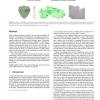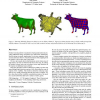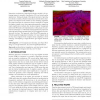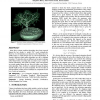100
click to vote
VISUALIZATION
2002
IEEE
15 years 5 months ago
2002
IEEE
This paper introduces a method for smoothing complex, noisy surfaces, while preserving (and enhancing) sharp, geometric features. It has two main advantages over previous approach...
57
Voted
VISUALIZATION
2002
IEEE
15 years 5 months ago
2002
IEEE
115
Voted
VISUALIZATION
2002
IEEE
15 years 5 months ago
2002
IEEE
While many methods exist for visualising scalar and vector data, visualisation of tensor data is still troublesome. We present a method for visualising second order tensors in thr...
VISUALIZATION
2002
IEEE
15 years 5 months ago
2002
IEEE
Surface texturing aids the visualization of polygonal meshes by providing additional surface orientation cues and feature annotations. Such texturing is usually implemented via te...
VISUALIZATION
2002
IEEE
15 years 5 months ago
2002
IEEE
The bioactivity of a molecule strongly depends on its metastable conformational shapes and the transitions between these. Therefore, conformation analysis and visualization is a b...
113
click to vote
VISUALIZATION
2002
IEEE
15 years 5 months ago
2002
IEEE
We present a robust, noise-resistant criterion characterizing planelike skeletons in binary voxel objects. It is based on a distance map and the geodesic distance along the object...
101
click to vote
VISUALIZATION
2002
IEEE
15 years 5 months ago
2002
IEEE
In this paper we introduce, analyze and quantitatively compare a number of surface simplification methods for point-sampled geometry. We have implemented incremental and hierarchi...
111
click to vote
VISUALIZATION
2002
IEEE
15 years 5 months ago
2002
IEEE
Interactive visualization of large digital elevation models is of continuing interest in scientific visualization, GIS, and virtual reality applications. Taking advantage of the r...
91
Voted
VISUALIZATION
2002
IEEE
15 years 5 months ago
2002
IEEE
Many direct volume rendering algorithms have been proposed during the last decade to render 2563 voxels interactively. However a lot of limitations are inherent to all of them, li...
121
Voted
VISUALIZATION
2002
IEEE
15 years 5 months ago
2002
IEEE
Typically 3-D MR and CT scans have a relatively high resolution in the scanning X;Y plane, but much lower resolution in the axial Z direction. This non-uniform sampling of an obje...




